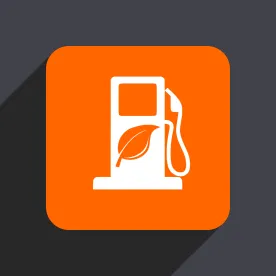Researchers Develop New Technique to Extract Alternative Fuel Source from Biomass
-
A consortium of researchers from universities in Switzerland, China, and Spain have created a novel metal organic framework, based on copper ions and carborane-carboxylate ligands, capable of extracting butanol from fermented biomass via absorption.
-
Butanol is a potential alternative fuel to gasoline that can be created from biomass via acetone-butanol-ethanol fermentation. The fermentation process yields a watery broth consisting of two percent butanol by weight. Extracting the butanol can be challenging, however, because it requires a separation tool that performs in an aqueous environment that also contains organic solvents. The difficultly of efficiently separating butanol from fermented biomass is a barrier to widespread adoption of butanol. The new framework may be more efficient than distillation and other extraction methods. As a result, extracting butanol may be less expensive and difficult.
-
Butanol is an alternative fuel candidate for gasoline-powered engines because it is almost as energy-dense as gasoline, but can be produced from renewable sources. The researchers foresee their new separation method as an important step in widespread adoption of butanol as a renewable fuel source. The researchers are now looking to partner with industry to scale the separation method to a size sufficient to tackle industrial carbon dioxide emissions.
Southern California Edison Announces Historic Energy Storage Procurements
-
On 1 May 2020, Southern California Edison (“SCE”) announced seven executed contracts for battery-based storage that are slated to collectively secure 770 megawatts of lithium-ion battery-based energy storage. This electricity could power 770,000 homes, although the energy will power both commercial and residential infrastructure. The announcement marks one of the nation’s largest energy storage procurements. Most of the battery storage facilities are co-located near adjacent solar farms to charge the battery over the term of the contracts. The facilities are projected to go live by summer 2021.
-
SCE is the largest subsidiary of Edison International and is the primary electricity supply company in Southern California, servicing approximately 14 million people across 50,000 square miles. It pursued these procurements to assimilate more wind and solar renewable energy into the grid, strengthen the region’s grid reliability during peak loads, and compensate for the retirement of once-through cooling systems at coastal power plants.
-
Other utilities around the country may adopt a similar strategy to meet state-mandated carbon footprint reduction goals while maintaining grid reliability.
Australian Researchers Achieve Breakthrough in Solar Window Concept
-
Material researchers and scientists from Monash University and the Commonwealth Scientific and Industrial Research Organisation of Australia have developed a semi-transparent solar cell made of perovskite that can be imbedded in glass windows. Perovskite has been hailed as the future of solar technology because is one of the few naturally occurring, high-abundance minerals that can easily convert light to electricity. Previously, perovskite lacked the stability to serve as a primary conductor. By adding a specific polymer, the researchers created a longer-lasting cell while increasing electric conversion efficiency to a record level.
-
Solar cell technology is currently restricted to traditional photovoltaic cells mounted on horizontal surfaces, using expensive silicon as the primary conductor. In those traditional rooftop solar generators, conversion efficiency rates range from 15 to 20 percent. Using perovskite to replace silicon is a less expensive alternative, which creates on average a 17 percent conversion efficiency rate. In addition, perovskite windows create a higher-energy yield opportunity compared to rooftop installation due to the nature of high-rise construction. Integrating solar cells into windows without impairing visual transparency could expand solar capacity materially.
Researchers Develop Self-forming Membrane to Improve Carbon Capture
-
Researchers at Newcastle University have developed a self-forming membrane that separates carbon dioxide from other gases. Instead of building a membrane entirely of silver, the researchers added a small amount of silver and used aluminum oxide supports in pellet and tubular form to grow silver within the membrane. Growing the silver-based portion of the membrane effectively reduces the demand for silver and thus the cost of manufacturing carbon-capture membranes. The technology would also likely reduce the size of the equipment required significantly and potentially reduce operating costs.
-
Through permeation measurements, the researchers demonstrated the membrane’s performance to be at the level required to be competitive with existing carbon capture processes. For instance, the flux of carbon dioxide was the highest reported for this class of membrane.
-
Carbon capture technologies allow harmless gasses to pass through a membrane into the atmosphere. The captured carbon dioxide can then be processed and stored. This process can be used in reaction engineering or to protect the environment by reducing carbon dioxide levels in the atmosphere. To date, the cost of carbon capture has limited the advantages of this technology. This development could help reduce operating costs, thereby increasing adoption.
Several European TSOs Join to Launch a Cross-border, Blockchain-based Energy Platform
-
On 23 April 2020, three of the largest transmission system operators (“TSOs”) of Europe’s electricity grid—TenneT, Swissgrid, and Terna—announced a partnership to develop a cross-border, blockchain-based platform to utilize the capacity of electric vehicles and house batteries to help balance the electricity system. Known as Equigy, the platform will be launched in Germany, Italy, the Netherlands, and Switzerland. Other TSOs expected to join after the initial launch.
-
The open-source, blockchain platform will be offered free-of-charge to users in an effort to balance the millions of storage facilities and small energy producers across Europe. The technology is expected to create a system for secure, efficient, and transparent transactions creating flexibility and easy access to electricity markets. The system is also expected to reduce major fluctuations in the market, allowing for a more balanced and efficient energy supply.





 />i
/>i
